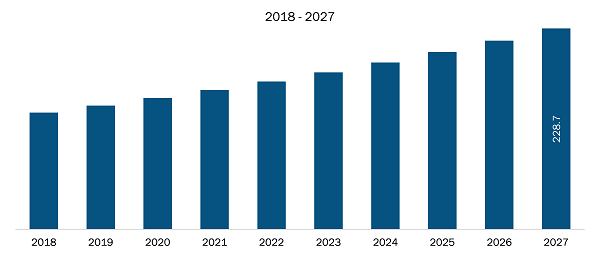The industrial agitator market in Europe is expected to grow from US$ 748.0 Mn in 2018 to US$ 1355.9 Mn by the year 2027, with a CAGR of 6.9% from the year 2019 to 2027.
Driving factors such as the positive economic growth outlook, increasing industrialization across the globe, and increasing demand for efficient agitation systems from industries are boosting the growth of the industrial agitator market. Further, the demand for innovative/custom industrial agitators from the growing number of SMEs is anticipated to drive the industrial agitator market growth in the near future. However, high installation costs and recurring service & maintenance costs are hindering the industrial agitator market growth. Industrial agitators are mechanical devices that are used for mixing/blending/stirring applications in diverse industries such as general industry, chemicals, mining, oil & gas, food and beverages, and cosmetics. These agitators are used in various heavy duty mixing applications and come in various types, for instance, large tank agitators and drum agitators. Hence, the installation costs/capital investments, especially for large tank agitators, are quite high, especially for small and medium manufacturing companies. Moreover, an industrial agitator consists of many mechanical parts such as drives, shafts, seals, and propellers. All these parts are subject to wear and tear and require regular service and maintenance for uninterrupted operations and high performance. Hence, the high installation costs and recurring service & maintenance costs may hamper the growth of industrial agitators in the coming few years, especially in small and medium industries.
On the basis of mounting type, the industrial agitator market is segmented into top-mounted, bottom-mounted, and side-mounted. The mounting configuration of industrial agitators depends on the requirements of end-use industries such as chemical, paper and pulp, ethanol and biofuels, water and wastewater, food and beverages, energy & power, and various other general process industries. The modularity of industrial agitators helps in achieving easy installation, maintenance, and optimum design requirements and hence, results in high quality and improved performance. During the forecast period of 2019 to 2027, the top-mounted segment is anticipated to be the largest contributor in the Europe industrial agitator market. However, side-mounted is projected to be the fastest-growing mounting type over the forecast period.
Germany dominated the industrial agitator market in 2018 and is expected to dominate the market with the highest share in the Europe region through the forecast period. In addition, Russia is expected to growth at a significant growth rate in the coming years. The figure given below highlights the revenue share of the rest of Europe in the industrial agitator market in the forecast period:
Rest of Europe Industrial agitator Market Revenue and Forecast to 2027 (US$ Mn)

- This FREE sample will include data analysis, ranging from market trends to estimates and forecasts.
EUROPE INDUSTRIAL AGITATOR MARKET SEGMENTATION
By Type
- Large Tank Agitator
- Portable Agitator
- Drum Agitator
By Mounting Type
- Top-Mounted
- Bottom-Mounted
- Side-Mounted
By Mixing Type
- Solid–Solid Mixture
- Solid–Liquid Mixture
- Liquid–Liquid Mixture
- Liquid–Gas Mixture
By End-Use Industry
- General Industry
- Chemicals
- Mining
- Oil & Gas
- F&B
- Cosmetics
By Country
- France
- Germany
- UK
- Italy
- Russia
- Rest of Europe
Industrial Agitator Market - Companies Mentioned
- Alfa Laval
- Mixel Group
- Ekato Group
- Philadelphia Mixing Solutions, Ltd.
- Silverson Machines, Inc.
- SPX Flow, Inc.
- Statiflo Group
- Sulzer Ltd.
- Tacmina Corporation
- Xylem Inc.
Europe Industrial Agitator Report Scope
| Report Attribute | Details |
|---|---|
| Market size in 2018 | US$ 748.0 Million |
| Market Size by 2027 | US$ 1355.9 Million |
| CAGR (2019 - 2027) | 6.9% |
| Historical Data | 2016-2017 |
| Forecast period | 2019-2027 |
| Segments Covered |
By Type
|
| Regions and Countries Covered |
Europe
|
| Market leaders and key company profiles |
|
- Historical Analysis (2 Years), Base Year, Forecast (7 Years) with CAGR
- PEST and SWOT Analysis
- Market Size Value / Volume - Regional, Country
- Industry and Competitive Landscape
- Excel Dataset
Recent Reports
Testimonials
Reason to Buy
- Informed Decision-Making
- Understanding Market Dynamics
- Competitive Analysis
- Identifying Emerging Markets
- Customer Insights
- Market Forecasts
- Risk Mitigation
- Boosting Operational Efficiency
- Strategic Planning
- Investment Justification
- Tracking Industry Innovations
- Aligning with Regulatory Trends





















 Get Free Sample For
Get Free Sample For